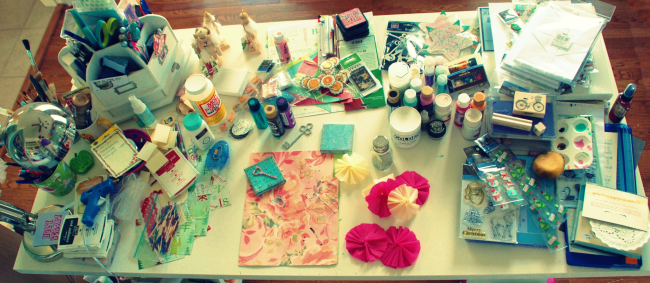In Support of Inventory Drafts
Thu Feb 11 2016
More than once I’ve heard writers tell each other these two things:
Until you write it, you’ve got nothing.
It’s ok to write a shitty first draft.
And yes, they really do say that second one. Both are variations on the same idea, one I agree with: No matter how fabulous your story’s concept is, until you get it out of your own head, it’s worthless.
But while I like the first saying, I don’t really appreciate the second one. In its attempt to be irreverent, I think it can also be de-motivating. I certainly don’t like the idea of doing all the work necessary to write a first draft only to end up with a result that is best described as "shitty."
So I prefer this:
It’s ok to write an inventory draft.
Writing uncertainly
Let’s face it. We don’t always know what our stories are going to be when we start them.
Sure, we have ideas. We might start with a core premise, or an idea for a character, or a particular dramatic moment in time, or even just part of a setting. Or maybe some hodge-podge of all of these.
But sometimes we write with a lot of uncertainty about what the pieces of our story are. We don’t know how they’re going to interact with one another, or whether they’ll work on the page like they do in our heads.
And that’s ok. It’s nice if can write with a full plot in mind, but it’s hardly mandatory. Certainly, you shouldn’t let the lack of a full plot stop you from writing.
It’s just that when you write in the face of those uncertainties, the result is usually an inventory draft rather than a true first draft.
Inventory drafts
An inventory draft is one in which the point of the manuscript is to resolve those uncertainties. The point is to get the story’s main elements out of your head and onto paper.
Once they’re out, you can take an inventory of them and figure out how they ought best fit together.
An inventory draft is experimental. It’s about running with your ideas to see where they lead, how they interact, and whether they work like you wanted. It’s not about telling a tightly crafted story.
An inventory draft’s plot is secondary. And realistically? Chances are the plot will have some pretty major holes. Such plots will often roughly outline the shape of a story that could work. That’s part of the experiment, and comes out of how the pieces interact. But don’t expect it to be flawless from the get-go.
What next?
So you’ve got an inventory draft on your hands. What do you do with it?
Probably the best thing to do is just set it aside for a few months. Get your own head out of it for a while so you can come back fresh later. When you do, re-read it from the perspective of assessing what’s there (which, by the way, I can help with). Try to answer the following questions:
- What’s your story’s core premise? Can you sum up the main idea of the story in one short sentence?
- Who are the major players in your story? What’s essential about them that you wouldn’t be willing to change?
- How do the major players relate to each other? Do you have a clear protagonist and antagonist to work with?
- What do the characters want, and do they have clear, coherent reasons for wanting it?
- What are the essential elements of your story’s world? If you’re writing fantasy or sci-fi, what pieces of world-building are essential to the story’s core premise?
- Did the inventory draft give you a rough plot outline to start from, or let you more clearly visualize how the story should go?
When you’ve answered those questions, you know what all your pieces are. You know what’s essential and what’s ok to change. And through the exercise of writing the inventory draft, you have gained experience with the how each piece behaves, putting you in position to build a strong plot with them.
What’s next, when you have an inventory draft, is to take inventory and then write the true first draft.
Plotting vs. pantsing
Everybody’s process is different, and you have to find what works for you.
I’m a plotter. I like to think things through as much as I can before I start writing, mostly because I’m neurotic and insecure about writing a "shitty first draft". Plotting lets me get out of my own way so that I can in fact write.
But not everybody works like that. Lots of people are perfectly fine taking their raw spark of an idea and diving head-first into that blank page, just to see where it goes. That’s fine too, but the result is usually an inventory draft.
Though the processes are very different, plotting and pantsing are exactly the same in one regard: both kinds of writers have to do a lot of work up-front before we’re ready to write our first draft.
The difference is what form that work takes. For the plotter, it’s abstract planning work. For the pantser, it’s writing.
Avoid the pitfall
The danger--and the whole reason I’m writing this article--is that for pantsers the up-front work masquerades as a draft of a novel. On the surface, an inventory draft looks like a first draft. If you print it out, the pages stack up just like a first draft. It has scenes and chapters just like a first draft.
But it’s not a first draft. It’s an inventory draft. And when you start passing it around for critiques, you might hear a lot of negative feedback that the story doesn’t work, or that the plot is full of holes, or people didn’t believe the characters would act that way, etc.
And of course they’ll say those things if they don’t know it’s an inventory draft. If they think you’ve given them a first draft, they’ll respond to it expecting a story whose pieces mesh together well. That’s not a realistic expectation for an inventory draft.
Then, if these people are writers, they’ll try to cheer you up by saying, "it’s ok to write a shitty first draft." And if you don’t realize that you wrote an inventory draft either, it’s easy to hear that message as "I’m a shitty writer."
No. You’re not a shitty writer. You’re probably just a pantser who still has work to do.
It’s ok to write an inventory draft. Maybe that’s your process. Just make sure you know that’s what you’re getting.

 @sonjablack.bsky.social
@sonjablack.bsky.social